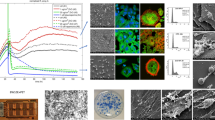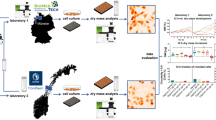Abstract
Continuously expanding use of products containing nanoclays for wide range of applications have raised public concerns about health and safety. Although the products containing nanoclays may not be toxic, it is possible that nanomaterials may come in contact with humans during handling, manufacture, or disposal, and cause adverse health impact. This necessitates biocompatibility evaluation of the commonly used nanoclays. Here, we investigated the cytotoxic effects of platelet (Bentone MA, ME-100, Cloisite Na+, Nanomer PGV, and Delite LVF) and tubular (Halloysite, and Halloysite MP1) type nanoclays on cultured human lung epithelial cells A549. For the first time with this aim, we employed a cell-based automated high content screening in combination with real-time impedance sensing. We demonstrate varying degree of dose- and time-dependent cytotoxic effects of both nanoclay types. Overall, platelet structured nanoclays were more cytotoxic than tubular type. A low but significant level of cytotoxicity was observed at 25 μg/mL of the platelet-type nanoclays. A549 cells exposed to high concentration (250 μg/mL) of tubular structured nanoclays showed inhibited cell growth. Confocal microscopy indicated intracellular accumulation of nanoclays with perinuclear localization. Results indicate a potential hazard of nanoclay-containing products at significantly higher concentrations, which warrant their further biohazard assessment on the actual exposure in humans.





Similar content being viewed by others
References
Ahamed M (2011) Toxic response of nickel nanoparticles in human lung epithelial A549 cells. Toxicol In Vitro 25:930–936
Brown DM, Wilson MR, MacNee W, Stone V, Donaldson K (2001) Size-dependent proinflammatory effects of ultrafine polystyrene particles: a role for surface area and oxidative stress in the enhanced activity of ultrafines. Toxicol Appl Pharmacol 175:191–199
Dong Y, Feng SS (2005) Poly(d,l-lactide-co-glycolide)/montmorillonite nanoparticles for oral delivery of anticancer drugs. Biomaterials 26:6068–6076
Floody MC, Theng BKG, Reyes P, Mora ML (2009) Natural nanoclays: applications and future trends: a Chilean perspective. Clay Min 44:161–176
Kagan VE, Konduru NV, Feng W, Allen BL, Conroy J, Volkov Y, Vlasova II, Belikova NA, Yanamala N, Kapralov A, Tyurina YY, Shi J, Kisin ER, Murray AR, Franks J, Stolz D, Gou P, Seetharaman JK, Fadeel B, Star A, Shvedova AA (2010) Carbon nanotubes degraded by neutrophil myeloperoxidase induce less pulmonary inflammation. Nature Nanotechnol 5:354–359
Lin FH, Lee YH, Jian CH, Wong JM, Shieh MJ, Wang CY (2002) A study of purified montmorillonite intercalated with 5-fluorouracil as drug carrier. Biomaterials 23:1981–1987
Lordan S, Kennedy JE, Higginbotham CL (2011) Cytotoxic effects induced by unmodified and organically modified nanoclays in the human hepatic HepG2 cell line. J Appl Toxicol 31:27–35
Mohamed BM, Verma NK, Prina-Mello A, Williams Y, Davies AM, Bakos G, Tormey L, Edwards C, Hanrahan J, Salvati A, Lynch I, Dawson K, Kelleher D, Volkov Y (2011) Activation of stress-related signalling pathway in human cells upon SiO2 nanoparticles exposure as an early indicator of cytotoxicity. J Nanobiotechnol 9:29
Napierska D, Thomassen LCJ, Lison D, Martens JA, Hoet PH (2010) The nanosilica hazard: another variable entity. Part Fibre Toxicol 7:39
Nayak PL, Sahoo D (2011) Chitosan-alginate composites blended with cloisite 30B as a novel drug delivery system for anticancer drug paclitaxel. Int J Plast Technol 15:68–81
Nel A, Xia T, Madler L, Li N (2006) Toxic potential of materials at the nanolevel. Science 311:622–627
Oberdorster G, Maynard A, Donaldson K, Castranova V, Fitzpatrick J, Ausman K, Carter J, Karn B, Kreyling W, Lai D, Olin S, Monteiro-Riviere N, Warheit D, Yang H (2005a) Principles for characterizing the potential human health effects from exposure to nanomaterials: elements of a screening strategy. Part Fibre Toxicol 2:8
Oberdorster G, Oberdorster E, Oberdorster J (2005b) Nanotoxicology: an emerging discipline evolving from studies of ultrafine particles. Environ Health Perspect 113:823–839
Powers KW, Brown SC, Krishna VB, Wasdo SC, Moudgil BM, Roberts SM (2006) Research strategies for safety evaluation of nanomaterials. Part VI. Characterization of nanoscale particles for toxicological evaluation. Toxicol Sci 90:296–303
Sharma AK, Schmidt B, Frandsen H, Jacobsen NR, Larsen EH, Binderup ML (2010) Genotoxicity of unmodified and organo-modified montmorillonite. Mutat Res 700:18–25
Soto K, Garza KM, Murr LE (2007) Cytotoxic effects of aggregated nanomaterials. Acta Biomater 3:351–358
Stearns RC, Paulauskis JD, Godleski JJ (2001) Endocytosis of ultrafine particles by A549 cells. Am J Respir Cell Mol Biol 24:108–115
Stoeger T, Reinhard C, Takenaka S, Schroeppel A, Karg E, Ritter B, Heyder J, Schulz H (2006) Instillation of six different ultrafine carbon particles indicates a surface area threshold dose for acute lung inflammation in mice. Environ Health Perspect 114:328–333
Suresh R, Borkar SN, Sawant VA, Shende VS, Dimble SK (2010) Nanoclay drug delivery system. Int J Pharm Sci Nanotechnol 3:901–905
Warheit DB (2008) How meaningful are the results of nanotoxicity studies in the absence of adequate material characterization? Toxicol Sci 101:183–185
Warheit DB, Webb TR, Sayes CM, Colvin VL, Reed KL (2006) Pulmonary instillation studies with nanoscale TiO2 rods and dots in rats: toxicity is not dependent upon particle size and surface area. Toxicol Sci 91:227–236
Acknowledgments
The authors would like to acknowledge Enterprise Ireland for financial support under the Grant Number PC/2009/0036 thorough commercialization technology programme. NKV was supported by the SFI funded CRANN-HP collaboration during a part of this study.
Author information
Authors and Affiliations
Corresponding author
Rights and permissions
About this article
Cite this article
Verma, N.K., Moore, E., Blau, W. et al. Cytotoxicity evaluation of nanoclays in human epithelial cell line A549 using high content screening and real-time impedance analysis. J Nanopart Res 14, 1137 (2012). https://doi.org/10.1007/s11051-012-1137-5
Received:
Accepted:
Published:
DOI: https://doi.org/10.1007/s11051-012-1137-5




